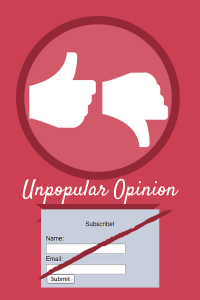U.S. culture (and many others) valorize hard work. We grow up steeped in the messaging that success is correlated to how hard you’re willing to work, and that developing a skill requires relentless hours of practice. And while that isn’t exactly inaccurate, it’s not the full picture.

For writers—and knowledge workers in general—the quality of your ideas and output depends on finding the right balance between work and rest. Contrary to our cultural narratives, working too hard can hurt your results. And at the same time, it can diminish your quality of life and do serious harm to your health.
This isn’t a personal opinion—it’s backed by research. Taking time for rest doesn’t make you lazy or a bad worker. It’s one of the most commonly overlooked ways to become a better writer.
5 Ways Rest Will Improve Your Content Writing
In an ideal world, knowing that rest is important for your physical and mental health would be a good enough reason to make it a priority. In the world we’re all stuck in though, rest is too often associated with personal guilt and/or accusations of laziness.
In many workplaces, managers will punish employees that take time off, and reward those who put in longer hours. But even for freelancers and business owners that work for ourselves, it’s hard to shake the idea that you’re doing something wrong when you take breaks or give yourself days off.
So, for those of you that need to hear it: rest doesn’t make you lazy. Instead, scheduling rest—being intentional about it—is a strategic move you can make to improve your business performance. And here’s why.
1. When you work too hard, your work suffers.
Conventional wisdom suggests that the more hours you work, the more you’ll get done. Actual research has proven that’s not true. Human brains and bodies have their limits. When you try to push yours past those limits, your work suffers. Not only will you produce less, but as your exhaustion increases, the work you do produce will be of lower quality.
The feelings of guilt many of us face when we take time off are illogical. Avoiding overwork isn’t the selfish, indulgent thing to do. It’s the best choice for anyone who cares about producing quality work.
2. Rest gives creativity room to grow.
If you know many creatives, then you’ve heard anecdotes about the “a ha!” moments that hit when in the shower or on a long walk. That happens for a reason. When you allow the brain periods of rest in between those of intense focus, the brain doesn’t turn off. Instead, a different part of the brain goes to work—a part that excels in creativity*.
When you’re trying so hard to make progress on a piece—staring at a blank page and just getting nowhere—sometimes the most productive move you can make is to step away and do something entirely different. A walk, exercise, a shower, cooking, playing with your pets—anything that explicitly shifts your mind away from the work.
It may feel counterintuitive, but letting your mind wander can help you accomplish more than trying to whip it into gear when you’re nearing a breaking point.
3. Rushed work gets sloppy.
When you overload your calendar, you’ll end up cramming work in when you don’t have the proper time and energy to give to it. Rushed work will be more prone to errors—from minor ones, like embarrassing typos, to bigger issues, such as pieces that lack research and get information wrong (yikes!).
If you don’t give yourself room to breath with the amount of work you schedule, the mistakes that make it into your pieces will hurt your reputation. And just as bad, they could lead your readers astray in their search for accurate, useful information.
4. Rest is required to avoid burnout.
Short periods of stress and overwork can take their toll. But once they become your norm, you face the bigger issue of burnout. And once you hit the point of burnout, not only will your health suffer, but you’ll struggle to get anything done. Work goes from feeling challenging to impossible. You go from being worn out at the end of the day, to tired all the time. And motivation will feel entirely out of reach.
In short, burnout is serious and best avoided. To keep from reaching that point and facing all the personal and career consequences that come with it, you need to start prioritizing rest before the days and weeks of overwork pile up to the point where it’s too late.
5. All work and no play makes you dull.
Unless you’re staying at a secluded, haunted hotel throughout the winter, working too hard probably won’t make you a murderer. But it does risk making you less relatable, which matters when it comes to writing. Interacting with friends and family members can produce insights you won’t get while sitting at your computer. Spending time reading books, watching movies, and following current events will keep you learning.
And the experiences you have while living life (away from work) will often come back in surprising ways that make your writing better. Maybe something that happens while walking your dog becomes the perfect anecdote to start a piece with, or a friend’s comment at a party sparks a great topic to tackle on your blog.
When all you ever do and think about is work, you lose insight into a lot of the things your audience cares about. Keeping in touch with the culture outside of your job helps you keep your writing interesting and authentic.
How to Intentionally Incorporate Rest into Your Work
Now that you have strong arguments for abolishing any guilt or hesitation you may have felt about adding more rest into your life, you need to develop specific strategies to make sure it happens.
1. Schedule in breaks.
When you’re busy (which most of us are most of the time), the idea of including a break in your day may feel impossible. But that’s why it’s important to intentionally schedule it. Treat it like a task that’s as important as any other item on your to-do list (because it is). The breaks you include in your day will make the time you spend focusing on work more productive.
And by being more intentional about the breaks you take, you’ll likely find you spend less time on unintentional breaks <cough> Twitter/Facebook/Instagram <cough>. And that means you can spend your breaks doing something you actually like. Doesn’t a walk in your neighborhood sound nicer than another twenty minutes of doomscrolling?
2. Enforce a strict line between the workday and your personal life.
Make a rule for yourself right now: when you’re done with work for the day, you’re done. No checking email on your phone while you watch TV, or taking business calls that come in while you’re trying to have dinner with family. To truly get the benefits of rest, you need time where you’re psychologically detached from your work. And a voice in the back of your head urging you to check your work email just in case will keep you from that.
You’re a writer, not an OB-GYN with clients that could go into labor at any moment (or at least, if a client does go into labor, that’s very much not your responsibility!). This isn’t a job where time-sensitive emergencies are the norm. You don’t need to be on call to do your job well. And in fact, you’ll do your job better if you let yourself be all the way off when you’re not working.
3. Take weekends (or something comparable).
For freelancers and agency owners, the line between the workweek and weekend can get blurry. But it’s important to have full days off regularly.
If you find that you prefer to take Mondays and Thursdays off to Saturdays and Sundays, that’s fine! The particulars matter less than the idea. But don’t try to work seven days a week. Make sure you leave yourself weekends to rest, spend time with loved ones, and pursue any hobbies you’re into.
4. Commit to regular vacations.
If you’re employed, use your vacation time! Don’t feel bad using the benefit you’ve earned. And don’t feel like you need to keep an eye on your email while you’re gone.
Note: I recognize that If you have an employer that requires this, you may not have much of a choice. But to the degree possible, leave work behind completely. And if you don’t have that option now, seriously consider looking for an employer who respects the value of rest.
If you work for yourself, make scheduling vacations a priority. Something a lot of people don’t realize about freelancing until they’re in it is that somehow it becomes harder to take time off when you control your own schedule. Many freelancers fall into the trap of forgetting to take vacation, or feeling like they can’t for the first few years (hi, it me). That’s a surefire path to burnout.
Communicate with your clients in advance and schedule all your deadlines to make sure they won’t interfere with the time you’ve allotted for your vacation. It really is OK to put an out-of-office message up and leave work behind for a week or two. The alternative is the real danger to your career.
5. Get comfortable saying “no” (and “not now”).
For everything else on this list to be possible without burning bridges and disappointing people, you need to avoid overcommitting. That means getting really good at using a small and simple word that is surprisingly difficult to say: no.
Don’t feel like you have to agree to everything a boss asks you to do. Don’t think you have to take on every project a client offers. Getting comfortable with saying “I don’t have the space in my calendar for that right now” takes work, but it’s important. And saying “no” doesn’t make you unprofessional. A lot of people will respect you more for showing that you know how to schedule effectively, set realistic expectations, and communicate boundaries.
Sometimes saying “no” outright is important. Other times saying “I can’t fit that in now, but could slot it in X weeks from now” will do the trick. Get in the habit of figuring out how much you can manage without going overboard, and protecting your schedule from going beyond that.
Conclusion
The internet is packed with articles about productivity hacks. But a lot of them miss this crucial part of the equation. If you’re not taking enough breaks, getting enough sleep, and keeping portions of your life entirely work-free, your productivity will dip. Your work will suffer. And you’ll hit a wall where you just can’t keep it up any more.
For the good of your personal life, your health, and your writing—take a break.
*If you want to know all the sciency stuff behind this, you can find it in the chapter on “The Problem of Rest” in the book Rest: Why You Get More Done When You Work Less by Alex Soojung-Kim Pang. It also has sections that cover a lot of the research referenced elsewhere throughout the post. [jump back up]




